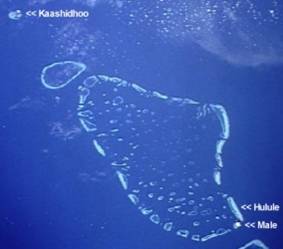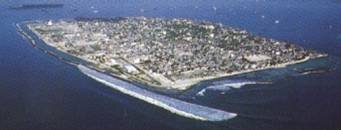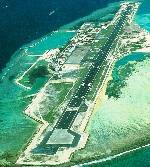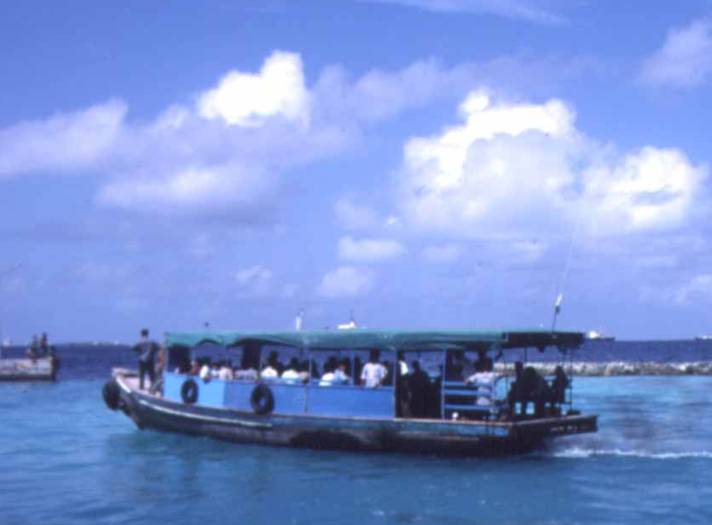
 Greg
McFarquhar
University of Illinois
Greg
McFarquhar
University of Illinois
|
INDOEX
 |
 |
 |
 |
| The Republic of Maldives, where INDOEX examined how aersosols from the Indian subcontinent impacted clouds and radiation. Flights were based out of the Maldives and a remote observatory was on Kashidhoo. | The capital island of the Maldives, where all participants of INDOEX lived during the field project. | The landing strip on the airport island of Hulule, where the NCAR C-130 was based during INDOEX. | The local boats called "dhonis" that were used to transport project participants between the capital island of Male to the airport island of Hulule. |
| INDOEX: During the winter monsoon, anthropogenic pollutants from the Indian subcontinent are transported southwards over the Indian Ocean. The goals of the Indian Ocean Experiment (INDOEX) were to characterize the individual aerosol particles, to examine the global and regional impacts of this Indo-Asian haze and to determine the impacts of aerosols on the regional energy and water balance (i.e., to determine the first, second and semi-direct aerosol effects). INDOEX was conducted in February and March of 1999 and was sponsored by the National Science Foundation, the Department of Energy and other agencies. The principal aircraft supported by the National Science Foundation was the National Center for Atmospheric Research C-130, which was based out of Male in the Repbulic of the Maldives. |
| Uof Illinois Role and Interests: Before Prof. McFarquhar joined the University of Illinois, he participated in INDOEX and was responsible for processing the data from the in-situ cloud microphysical probes and the Scanning Aerosol Backscatter Lidar (SABL). Since his arrival at the University of Illinois, Prof. McFarquhar and graduate student Hailong Wang have continued to analyze these data and used them to compare against the results of their numerical cloud models, calculating the imapcts of aerosols on the regional water and energy cycles. |
Publications arising from INDOEX: McFarquhar, G.M., J.-P. Chen, C. Volpe, and A. Thakur, 1994: INDOEX: A preliminary survey. C4 Report, Available from Center for Clouds, Chemistry, and Climate, University of California at San Diego, La Jolla, CA, 23 pp. Heymsfield, A.J., and G.M. McFarquhar, 2001: Microphysics of INDOEX clean and polluted trade cumulus clouds. J. Geophys. Res., 106, 28653-28673.
McFarquhar, G.M., and A.J. Heymsfield, 2001: Parameterizations of INDOEX microphysical measurements and calculations of cloud susceptibility: Applications for climate studies. J. Geophys. Res., 106, 28675-28698.
Ramanathan, V., P.J. Crutzen, D. Althausen, J. Anderson, M.O. Andreae, A.D. Clarke, W.D. Collins, J.A. Coakley, A.J. Heymsfield, B. Holben, J. Hudson, A. Jayaraman, J.T. Kiehl, T.N. Krishnamurti, J. Lelieveld, G.M. McFarquhar, A.P. Mitra, T. Novakov, J.A. Ogren, I.A. Podgorny, J.M. Prospero, K. Priestly, P.K. Quinn, K. Rajeev, P. Rasch, S. Rupert, R. Sadourny, S.K. Satheesh, P. Sheridan, G.E. Shaw, F.P.J. Valero, 2001: The Indian Ocean Experiment: Widespread haze from south and south-east Asia and its climate forcing. J. Geophys. Res., 106, 28371-28398. McFarquhar, G.M., S. Platnick, L. Di Girolamo, H. Wang, G. Wind, and G. Zhao, 2004: Remotely sensed observations of aerosol indirect effects in the Indian Ocean. Geophys. Res. Lett., 31, L21105, doi:10.1029/2004GL020412. McFarquhar, G.M., and H. Wang, 2006: Effects of Aerosols on Trade Wind Cumuli over the Indian Ocean: Model Simulations. Quart. J. Roy. Meteor., 132, 821-844. Wang, H., and G.M. McFarquhar, 2008: Large-eddy simulations of the diurnal cycle of shallow convection and cloudiness over the tropical Indian Ocean. Quart. J. Roy. Meteor. Soc., 134, 643-661.
Wang, H., and G.M. McFarquhar, 2008: Modeling aerosol effects on shallow cumulus convection under various meteorological conditions observed over the Indian Ocean. J. Geophys. Res., 113, D20201, doi:10.1029/2008JD009914.
|
Thesis arising from INDOEX: Wang, Hailong, “Modeling and observational studies of shallow cumulus convection over the Indian Ocean: Aerosol and meteorological effects on diurnal cycles”, Ph.D> thesis 2007.
|